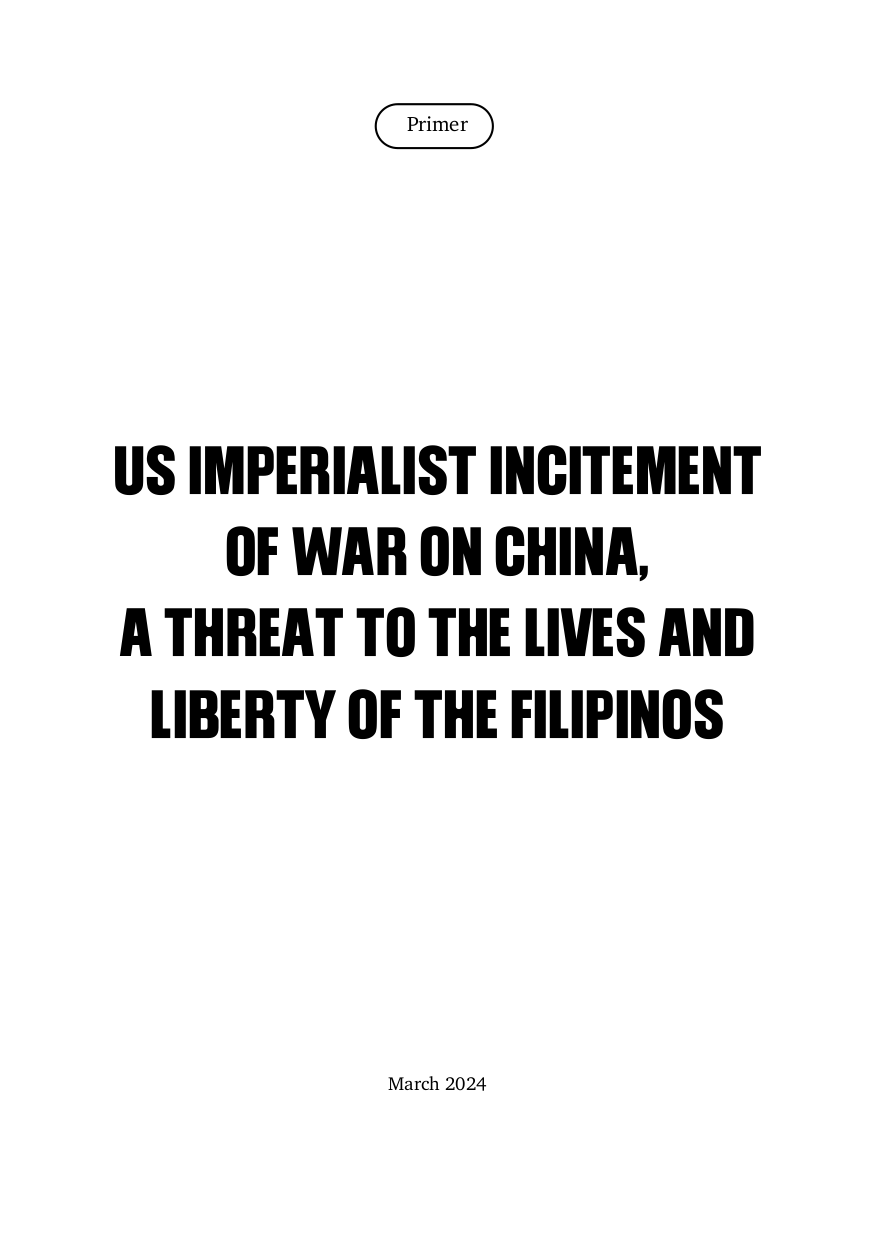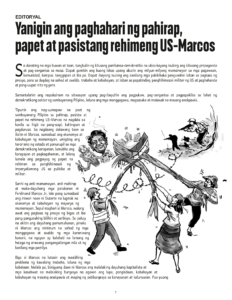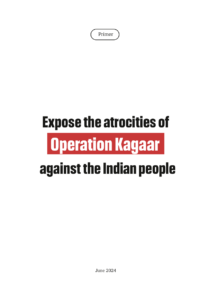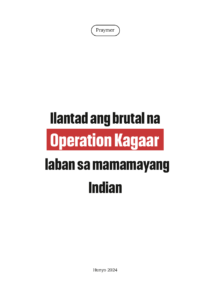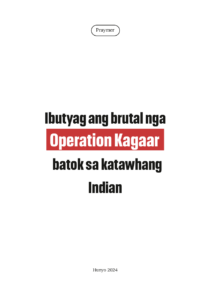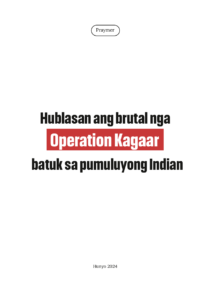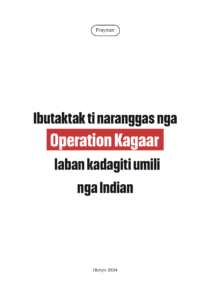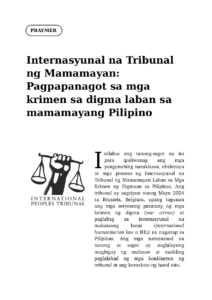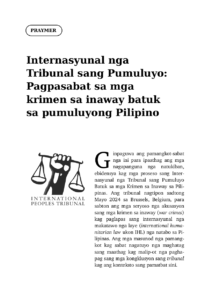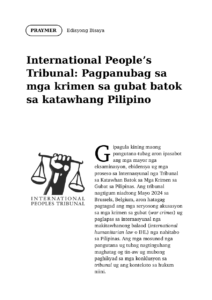(Primer) US imperialist incitement of war on China, a threat to the lives and liberty of the Filipinos
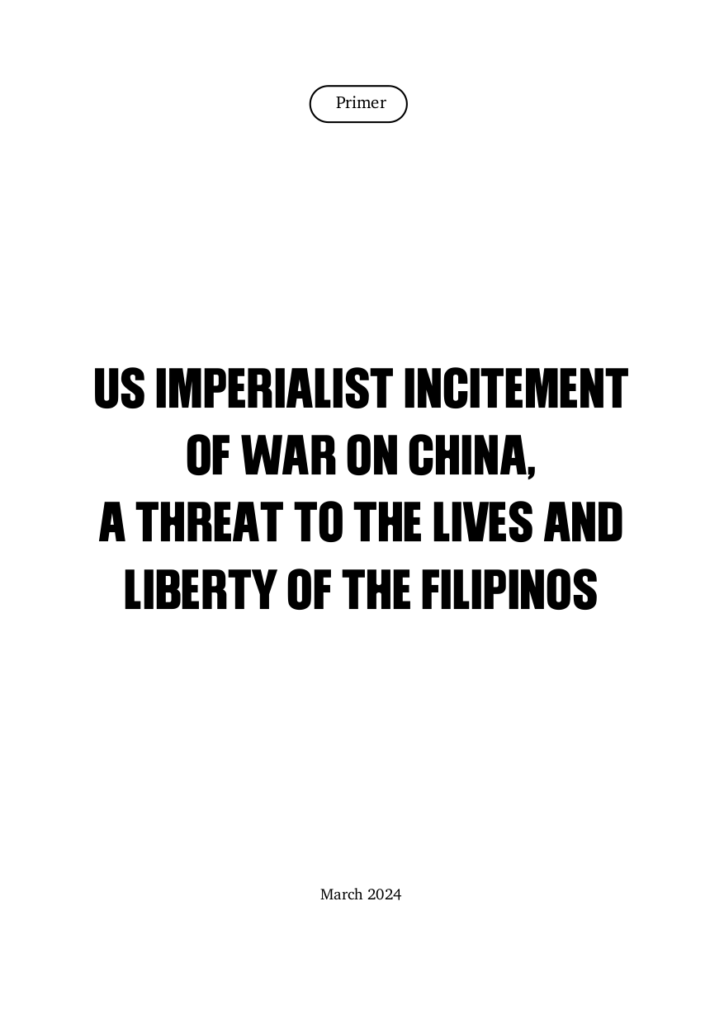
Introduction
Every year, the US launches more and larger wargames on the land, sovereign territories and immediate surrounding waters of the Philippines. Concurrentlly, it builds increasing numbers of military bases, outposts and facilities that serve as quarters for troops and storage of equipment, weapons, war vehicles and other arsenals (chemical, biological and nuclear) it uses to wage war and to “prepare the theater of war” against China. At any given time, thousands of American troops are present in the Philippines for navigation, port visits, “joint” activities and relentless wargames.
By controlling its arsenal, the US is further tightening its operational control over the Armed Forces of the Philippines (AFP). It is increasing its stockpiled bombs, weapons and obsolete military equipment in the pretext of “modernization” of the reactionary army. Using these weapons, the US aggressively intervenes on the AFP and the Marcos regime’s counterinsurgency campaign against the Filipino liberation movement, which has remained the strongest and biggest obstacle to its imperialist ambitions in the Asian region. Because of this, the AFP is becoming more dependent on the financial and military aid of the US, putting it more under US control.
The US’s current use of the AFP and Marcos’ puppet regime as pawns for the armed conflict or war against China is a threat to the lives of Filipinos and the country’s sovereignty. The Communist Party of the Philippines and the national-democratic movement must firmly lead and unite the entire Filipino people to defend the country’s rights against foreign military intrusion, promote the desire for peace, demand a peaceful foreign policy, and prevent the outbreak of inter-imperialist war that will implicate the Philippines.
1) What is the significance of Balikatan and other wargames in 2024?
The US and the AFP both boast that the 39th Balikatan planned for April and May will be the “biggest” in its history. It will focus on “key locations” in the western part of Palawan, an area with a heavy presence of Chinese ships. Its also targets the island of Mavulis, the farthest island in the province of Batanes adjacent to the Bashi Channel. It is only 200 nautical miles (about 370 kilometers) away from Taiwan’s Orchid Island.
Last year, more than 17,000 troopers conducted combat drills in the country (including Batanes) of which 12,000 were American, 5,000 Filipino and 100 Australian. For the first time, France, a key US ally in Europe, will participate in the wargames.
Balikatan 2024 is just one of more than 500 wargames and other military activities the US plans to conduct in the Philippines this year. This does not yet include the unilateral and more comprehensive wargames conducted by the US, alone or with its other allies in Asia, in or near Philippine territorial waters without the participation of the AFP.
Among them are the “large deck exercises” conducted by the US in the Philippine Sea in the eastern part of Taiwan, using its two warships and with the participation of a similar Japanese ship. These large ships, also called “floating military bases” stay indefinitely and without permission in the territorial waters of the Philippines by virtue of the extraterritorial rights granted by the Philippine puppet state to the US.
US floating military bases in Asia with 7,000 personnel and 90 aircraft:
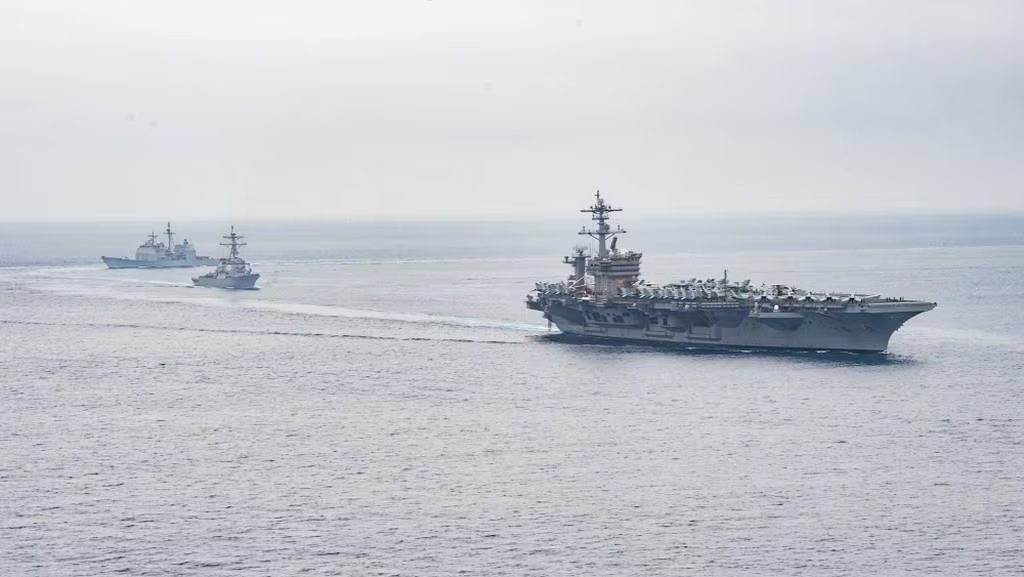
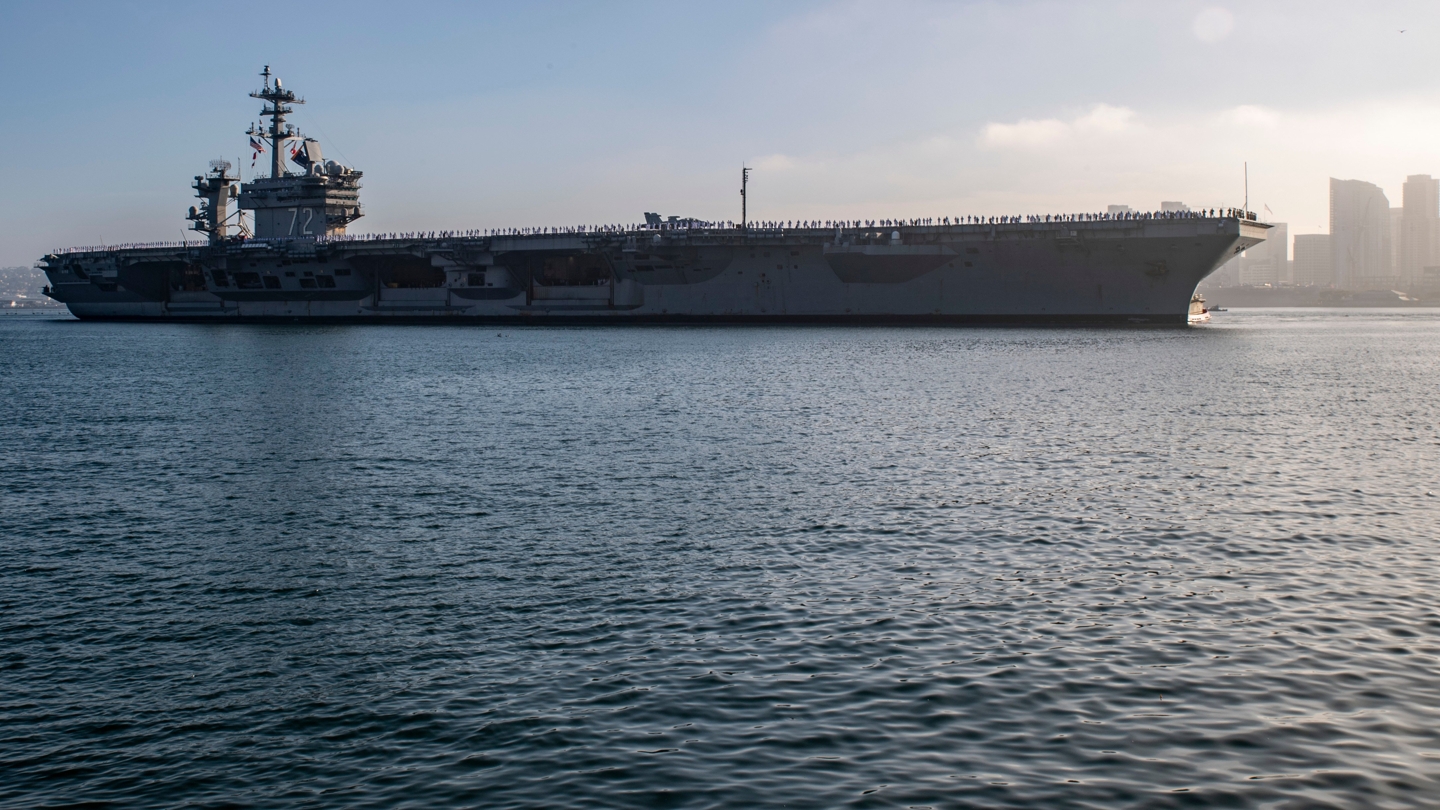

Batanes is troubled by the presence of Americans
Rice ran out on the island of Batan, Batanes in April 2023 when residents went on a panic buying spree after hearing that American troops would swarm the island for the Balikatan wargames. They are aware that the wargames are preparations for a possible conflict with Taiwan, despite denials from both the AFP and the US. “We don’t want to get involved in the trouble,” was the prevailing sentiment on the island at the time.
Unrest spread in the smallest Philippine province when the US used it in Balikatan as a playground for troops. The small island was swarmed with thousands of troopers, hundreds of ships and aircraft, cannons and other weapons. Simulated “beach landings” or the landing of US amphibious warships on the coast, the landing of huge and noisy Ospreys on the hills, and the firing of deafening HIMARS (High Mobility Artillery Rocket System) cannons were conducted there.
2) What is the AFP’s “strategic island defense”?
In the previous months, US, AFP and Marcos officials have kept prating about “pivoting” the AFP from “internal defense” to “external defense” since the New People’s Army is already “weakened” or “defeated.”. At the beginning of the year, Department of National Defense secretary Gilbert Teodoro announced the formation of the AFP’s Comprehensive Archipelagic Defense Concept (CADC). This defense plan supposedly aims to protect the Philippine’s exclusive economic zone in Palawan (where American and Chinese ships are ever present), and in Batanes (where the US plans to build permanent bases because of its proximity to Taiwan).
In fact, the CADC is a continuation of the US’s so-called “archipelagic defense strategy” which has pushed for the deployment of missile and cannon systems into what it calls the “first-island chain.” This strategy is touted as a way to prevent the expansion of the “threat” of Chinese military power. Behind this strategy is giving the US mainland a “deep defense” when war breaks out between it and China. That is, the countries in the “first-island chain” will mainly bear the devastation that a US-China war will bring, should it break out.
Part of this strategy is the bolstering of US troop presence and the positioning of weapons at its military bases in Japan and South Korea. A big part of this is the US saturating the Philippines’ north and west with military bases and facilities that will serve as launching pads for a missile attack that will fall right inside the mainland of China.
See map: Archipelagic Defense Strategy Overview
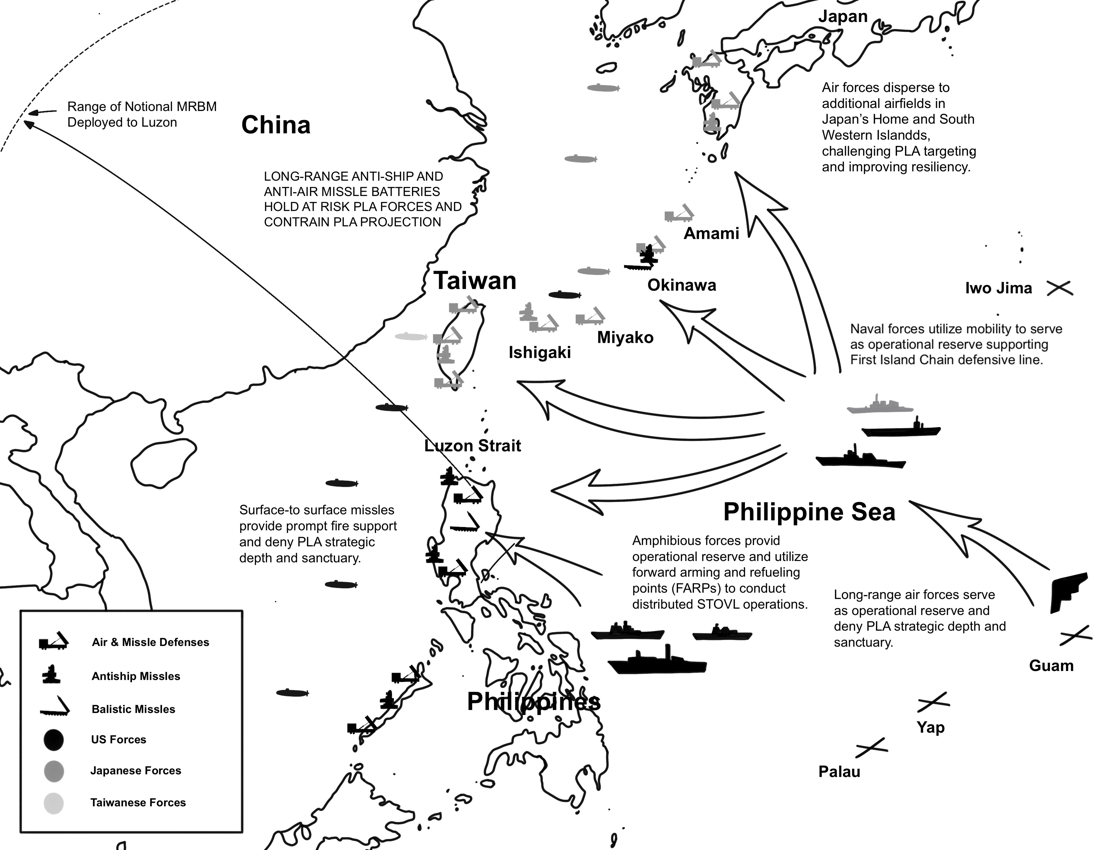
Contrary to its name, the “archipelagic defense strategy” is an offensive plan. This is supported by an aggressive and more comprehensive Indo-Pacific Security Strategy. At the same time, the US is strengthening its military alliances in Asia, such as AUKUS (Australia-United Kingdom-United States) and QUAD (US, UK, India and Japan).
3) How many US military bases and facilities have been built under EDCA?
Throughout 2023, using public funds, citizens’ resources and the manpower of its puppet AFP, the renovation of old ones and the construction of new US bases and facilities have been underway. Department of Defense secretary Gilbert Teodoro himself toured the country to ensure the completion of 95 projects (from 32) in the nine designated “Agreed Locations” under the EDCA.
Among those completed are the jet fuel depot and the construction of the American soldiers’ “command center” at Lal-lo Airpot in Cagayan (a civilian airport); expansion of the airport and construction of a warehouse and hangar at Basa Airbase in Pampanga; jet fuel depot at Mactan-Benito Ebuen Air Base in Cebu; and large buildings and barracks at Fort Magsaysay in Nueva Ecija. The dredging of the port, the laying of the airport and the construction of the military camp on Balabac Island in Palawan and other “EDCA sites” for the exclusive use of the US have also begun.
See map: “EDCA sites”
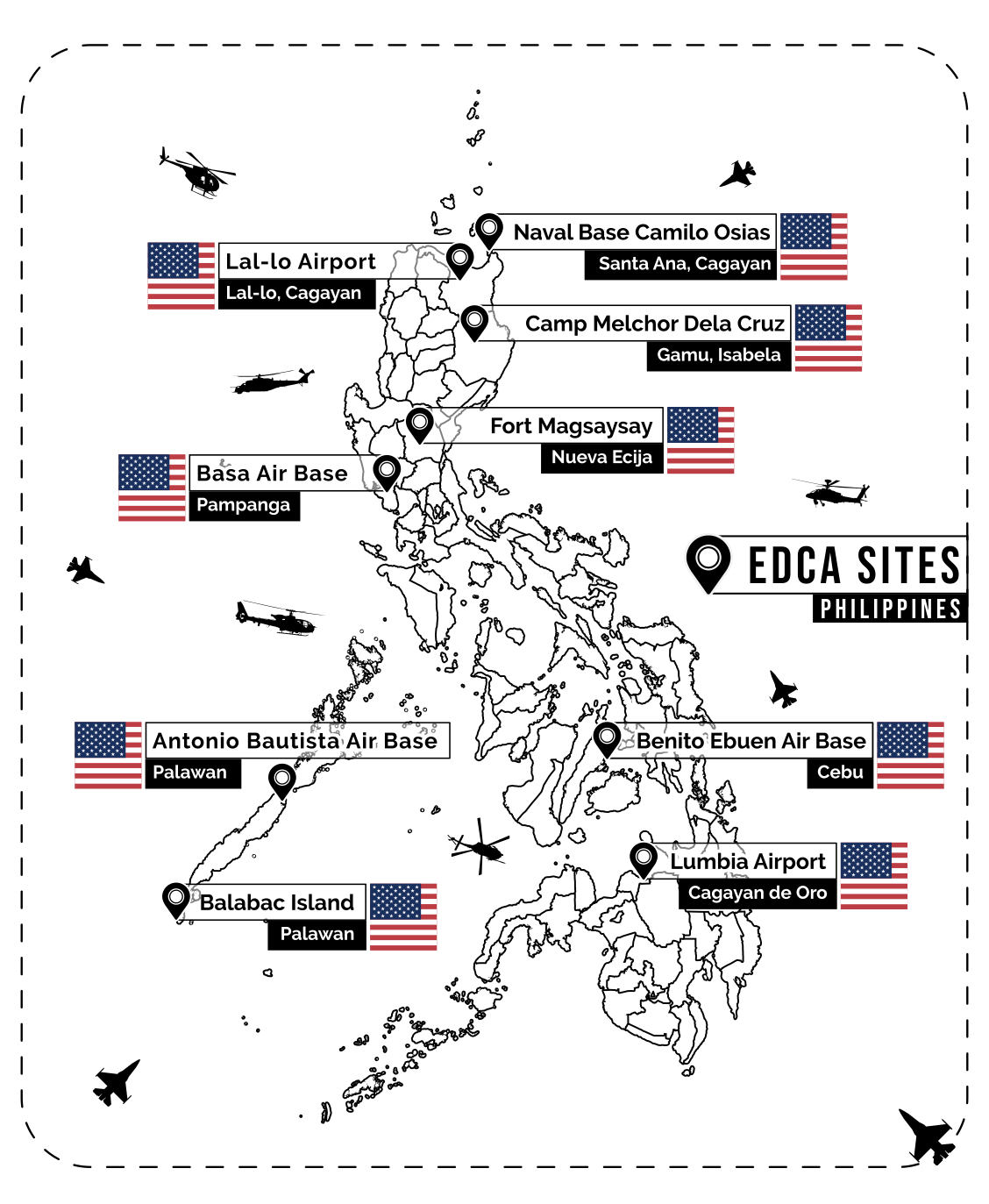
In September 2023, the US announced its intention to increase the nine existing bases. But even before this, affected masses have already reported the presence of American troops and the existence of their facilities in Ilocos Norte and some parts of Ilocos Sur and Oriental Mindoro. US naval forces are also using the former Subic Naval Base in Zambales purchased by an American arms company from Hanjin Industries, after it closed in 2019. The US is also reported to have stockpiled military equipment at the 25-hectare “AFP camp” in Calayan Islands in Cagayan and constructed two “civilian ports” in Batan Island in Batanes after using the island for Balikatan in 2023. This March, a senator disclosed that in fact, 16 and not only nine are being developed as “EDCA sites” for the US.
In addition are those not covered by the EDCA agreement but the AFP and the US do not disclose, such as Operation Pacific Eagle-Philippines in Zamboanga and Basilan, where US troops are permanently based, as well as other various communication facilities (Samar, Cebu, Mindoro, Boracay, Pangasinan, and many more).
Rescuers of American soldiers in Ilocos Norte
When the US launched military drills in San Joaquin, Sarrat, Ilocos Norte in March 2023, it involved some civilians in the barangay. “(During the training), we lifted American soldiers who pretended to be war casualties,” said a resident who participated in the training. “This means during a real war, we will be made to carry American war casualties. Damn, they were heavy!”
Despite having no “Agreed Location” in Ilocos Norte, US military infrastructure and facilities exist here. The US claimed 30 hectares of land in Barangay Bobon, Burgos, where 40 howitzer cannons were stationed. American soldiers also built structures that they boast of using for surveillance or monitoring Chinese military movements. The US also builds a seawall as wide as the road to fortify their base, hindering the seafaring and docking of fishermen.
Small fisherfolk were unable to fish when a 7-day simulation and live fire exercises was held in the area. “Our situation is precarious,” said one fisherman. “What if we are at sea and then their rockets suddenly start firing?”
4) What lopsided foreign agreements does the US use to maintain its presence in the country?
On May 1, 2023, Ferdinand Marcos Jr and US President Joseph Biden signed the Bilateral Defense Guidelines, a document that reaffirmed the Mutual Defense Treaty (MDT) of 1951, a colonial agreement that bound the Philippines to US foreign policy. In the “guidelines” prepared by the US, it stipulated the funding, training and arming of the AFP to make the puppet army serve in its goals against China. In April 2023, the Philippines signed a 5-10 year security plan for the “modernization” of AFP weapons, camps and facilities.
Ever since the MDT existed, it has been used by the US as a basis for blatantly interfering in the internal affairs of the country and dragging the Philippines into wars that it has entered into for the past seven decades.
In 1947, the US pushed through the Military Bases Agreement (MBA) and used 65,000 hectares of agricultural land and ancestral land to base American soldiers, and store its weapons, including nuclear weapons. The US used these bases as launching pads for aggression forces during these wars.
The MDT served as a stepping stone for other military agreements, especially after the Philippine Senate rejected the MBA in 1992. These include:
Visiting Forces Agreement: 1998, signed by the Ramos regime. Allowed the unrestrained movement and presence of large numbers of American troops, and granted them extraterritorial rights.
In 2006, the US created the Security Engagement Board (SEB), based on the VFA, to set the “common” activities” of the AFP and make it easier to manage large wargames like Balikatan. The SEB also determines what obsolete weapons the Philippines will “buy” from the US, under the US’s Foreign Military Funding program.
Enhanced Defense Cooperation Agreement: 2014, signed by the Aquino II regime. Authorized the construction of exclusive US military facilities and bases within AFP military camps to use as storage for US military supplies, or as quarters for American troops in the country.
This is now the basis for building military bases wherever the US wants in the country.
5) Is it true what the AFP says that it will focus on “external defense” and abandon counterinsurgency?
For now, there are no visible indications that the AFP intends to focus its attention on external defense, despite the DND secretary’s statements. Majority of its battalions are focused on the NPA’s guerilla fronts up to the present despite its claims that many, if not all, of the provinces are “insurgency-free” and that it has declared a “Stable Internal Peace and Security” situation in many parts of the country.
In fact, General Romeo Brawner Jr, AFP commander, again gave a deadline this March to crush all guerrilla fronts by March 31, all NPA vertical formations by June 30, and all NPA units by the end of the year. This order was accompanied by a series of aerial bombings and strafing and indiscriminate shelling of Abra, Negros, Bukidnon, Iloilo and Quezon. Its units are also relentlessly violating laws of modern warfare, and the human rights of millions of civilians.
From 2021, the US poured $2.1 billion worth of weapons given or sold to the Philippines including jet fighters, missiles, bombs, howitzers, and other weapons. At the behest of the US, the AFP intensified its counter-revolutionary war characterized by the use of state terrorism. In time with the start of Operation Pacific Eagle-Philippines, the Trump government pushed Duterte in October 2017 to declare the Party and NPA as terrorists and to end the peace talks. With the push of the US and its agents in the AFP and the security sector, the more ferocious “Anti-Terrorism Law” was enacted in 2020.
From then on the brutal counter-guerrilla tactics that the US also used in Vietnam were implemented, including harassment, extrajudicial killings, and aerial bombing. The widespread cases of AFP and PNP violations of human rights and violations of international humanitarian law are pushing some progressive lawmakers in the US to demand that the US stop providing military aid to the Philippines.
6) What are the roots of the US-China military rivalry?
The root of the US-China rivalry is economic rivalry, which began to escalate in the mid-2000s. Prior to this, the US and China had long been economic partners. Since the end of the 1970s, the US has supported China’s steady transformation from socialist to capitalist, with the complicity of China’s bureaucrat monopoly capitalists. The US favors China in trade and investment (“most favored nation”). This allowed China to develop its own industry while transferring an increasing share of production, especially in the field of technology.
State monopoly-capitalists in China benefitted from the offensive of neoliberalism or liberalization, deregulation, and privatization in China and worldwide. China rapidly transformed into an emerging imperialist power. Monopoly-capitalists in China exported capital in the form of loans and investments. In cooperation with Russia, it established its own economic bloc (BRICS) and military alliance (Shanghai Cooperation Organization).
China has repeatedly strengthened its military forces and its overseas operations. This includes the construction of military bases on seven artificial islands in the South China Sea and within Philippine maritime territory, to control trade routes there.
The construction of these military bases is blatant military aggression and against the maritime rights of the Philippines as recognized in the decision of the International Arbitral Tribunal under the United Nations Convention on the Laws of the Seas (UNCLOS). In the era of economic collusion, the US turned a blind eye to China’s muscle-flexing.
Following the 2008 financial crisis, US complaints intensified over its trade deficit with China, which controls a large portion of global trade. The US then pushed for the creation of trade blocs that excluded China, while implementing protectionist policies. In 2011, the Obama administration declared the “pivot to Asia” turning the focus of its military forces from Europe and the Middle East to Asia.
Under the Trump administration to the Biden administration, the US imposed measures on China’s economy, allegedly to sanction it for violating “international rules.” The US also exerted pressure on the import of agricultural products from China.
Virtual war in the sea of Mindoro
The waters of Occidental Mindoro became a virtual war zone when the US launched a “maritime cooperative activity” in Cabral Island, in the West Philippine Sea, in January. While American soldiers were showing off, along with their lackey Filipino soldiers, two Chinese warships stood guard from a distance.
The MCA aims to prepare US ships and Philippine naval forces to engage them in a naval war against China. The US has conducted three such activities in a row from December 2023 to February this year.
7) What is the Party’s stance on the Taiwan issue?
The CPP supports the people of Taiwan in their militant resistance to the US’s use of Taiwan as part of its geopolitical strategy. It condemns the US for interfering in China’s internal affairs, as well as China’s militaristic response. It supports the desire of the proletariat and people of both China and Taiwan for a peaceful and sober resolution of the issue of their reunification.
The CPP, and the Filipino proletariat and people, together with the whole world, stand against US warmongering in Asia and against its use of the Philippines as a launching pad for aggressions in Taiwan and against China.
The US has long been using Taiwan as a pawn in its Asian hegemony and economic and military confrontation with China. For the past 75 years, it has used Taiwan as an economic and military stronghold to advance its strategic geopolitical interests in the Asia-Pacific region. The US considers Taiwan as part of the “first-island chain” strategy to prevent the rise and strength of China as an imperialist rival. It actively funds and pushes groups in Taiwan to demand “independence” to undermine China’s hold on it. It continues to pour funds to build up Taiwan’s military strength.
8) Will the imperialist war between the US and China break out?
With US provocations against China, the possibility of an outbreak of war grows. This manifests the intensification of inter-imperialist rivalry amid a broad crisis of the global capitalist system.
The US tries to maintain itself as the leading and unique power in the world. It is an attempt to change the emerging division of the world and seize markets and sources of raw materials that are under the control of its rival imperialist powers. The US is provoking China as it continues to fuel the war in Ukraine against Russia.
The wars that the US is waging greatly benefit the largest US military companies that make billions of dollars in profits. In Ukraine, the US has stockpiled much of its surplus military equipment, while pushing other imperialist allies to hand over advanced weapons. The US is also piling up surplus military equipment in the Philippines.
However, any attempt by the US to invade China with armed forces is futile and will only fail, as has been proven several times in history when American troops entered mainland Asia (Vietnam, Korea, China). US military experts know this, so it is trying to create a military scenario of pushing China to “invade” Taiwan in order to justify “defending Taiwan.” Its aim is to push China to take the initiative and force it to “fire first” (“own the starting gun” is the term of Lt. Gen. James Bierman of the Third Marine Expeditionary Force). Bierman likens today’s US strengthening of military presence in Japan and the Philippines to the several years of preparations by the US for the war in Ukraine against Russia.
9) Why is the US instigation of war in Asia a threat to Filipino lives and sovereignty?
The extensive US incitement of wars, particularly the incitement of military confrontation with China over the issue of Taiwan, as well as the push to strengthen the operations of the Philippine Navy and Philippine Coast Guard in the West Philippine Sea, bring great threat to the lives of Filipinos and the country’s sovereignty, as well as to the lives and sovereignty of various countries in the world.
The construction of US military bases as part of the preparations for the US “theatre of war” against China is a direct violation of the Philippines’ right to self-determination. The US’s use of the AFP as a support force in military aggression is further undermining the country’s sovereignty.
It blatantly denies the right of Filipinos to have an independent foreign policy. It robs the Filipinos of the right to decide if participating in the war pushed by the US is in accordance with the national interest and wishes of the Filipinos.
The US is implicating the Philippines in its aggressive military policy. The possibility that the US could use its facilities in the Philippines to launch missiles, jetfighters, or service its warships, is not a far-fetched reason for China to target the country with a retaliatory attack.
The Marcos regime’s servility to US orders and betrayal of Philippine sovereignty is the reason the country is involved in wars that have nothing to do with its national interest. In exchange for military aid and political favors, the Marcos regime blindly obeys the wishes and needs of the US military to construct bases and facilities.
On the other hand, like the Duterte regime, the Marcos regime also has no backbone over China’s blatant violation of the Philippines’ maritime territory in building military bases there, and China’s seizure of the Philippines’ ocean resources. China’s oppresion, especially on Filipino fishermen, is now being used by the US publicity to justify and get the sympathy of the Filipinos for bolstering military presence in the South China Sea.
10) What are the tasks of the revolutionary movement in resisting the imperialist war between the US and China, and other imperialist wars in the world?
It is the duty of the revolutionary movement to unite the Filipino people under the flag of patriotism and mobilize the people to stand up, resist and defend the life and sovereignty of the country. Unleash the powerful movement that is anti-imperialist and against imperialist wars. If not, the country will likely be sucked up in the whirlwind of inter-imperialist war ushering the country into a new chapter of national suffering.
The people must fight for the urgent patriotic demand of repealing the MDT, EDCA, VFA and all the unequal military agreements with the US.
They must unite to fight the plan to build new military bases and facilities in the Philippines and dismantle the existing US military bases and facilities in the Philippines and expel all American troops from the Philippines.
They need to call for ending the US Operation Pacific Eagle-Philippines and the dismantling of its operations in the country.
They must stop launching Balikatan, other offensive wargames and other intrusive military activities.
Together with friends and peace-loving citizens abroad, the US should be compelled to stop military aid to the fascist Marcos regime.
Along with fighting against US imperialism, we must oppose and resist China’s continued militarization of the West Philippine Sea and advance the dismantling of all Chinese military bases and facilities in the West Philippine Sea.
The Party unites with and stands up for all people who are fighting US imperialist wars anywhere in the world. The Party is aware that the US uses war as an instrument to impose its hegemony on the world, in its conflicts with imperialist rivals and to suppress countries and movements that assert national sovereignty. Because of this, the people of the world are now facing its more than two-year proxy war against Russia in Ukraine, its and Israel’s heinous genocidal war in Palestine and the expanding armed conflict in the Middle East.
The unique contribution of the Party, the New People’s Army and the entire revolutionary movement against the inter-imperialist war is the promotion of the people’s democratic revolution through protracted people’s war and other forms of mobilizing the broad Filipino masses. The armed revolution in the Philippines serves as the biggest obstacle to US plans to incite and ignite an armed conflict in Asia.
_________
Prepared by:
Information Bureau
Communist Party of the Philippines
March 2024

